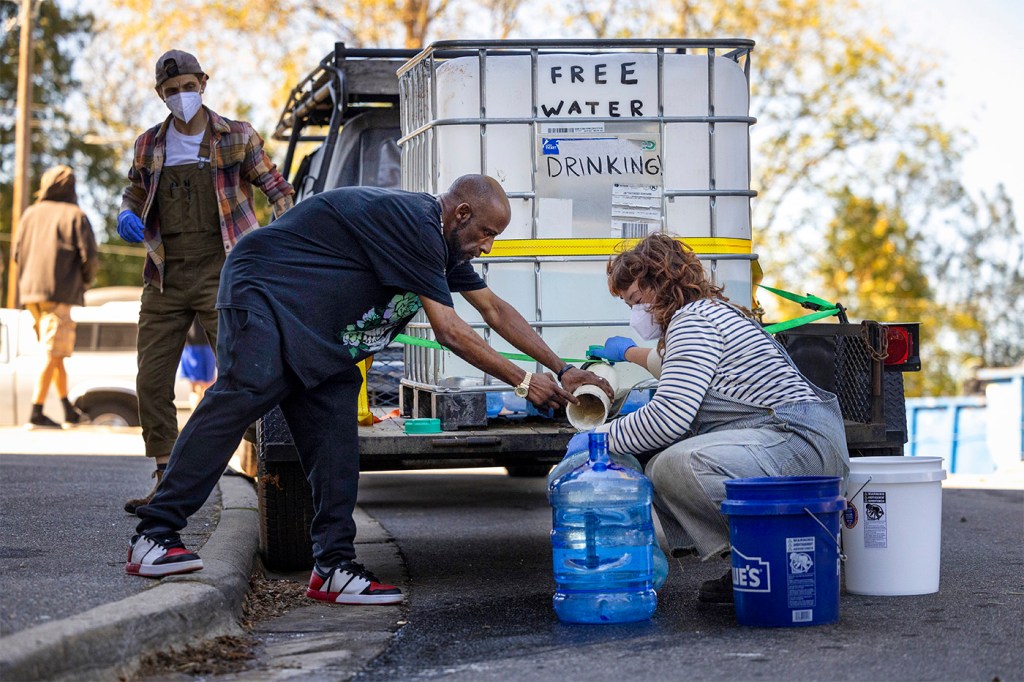North Carolina’s hurricane damage is not just limited to destroyed homes, but contaminated water systems, experts say
Western North Carolina residents were hit particularly hard by the flooding, not only because of the region’s geography, but because of the impact on the water system.

Hurricane Helene brought death and destruction to North Carolina, with the western part of the state in particular seeing entire towns and homes washed away.
In the aftermath of the storm, the state is facing many issues that could affect the welfare of its residents, including the quality of its water supply, according to one Northeastern University expert.
Many residents in the western part of the state get their water from home wells. These systems are prone to contamination during flooding events, leaving the people who use them at a higher risk of being exposed to E. coli and other bacteria if they don’t properly sanitize them, said Kelsey Pieper, assistant professor of civil and environmental engineering at Northeastern, who is helping the North Carolina Department of Health in its recovery efforts.
Pieper, who specializes in drinking water quality and post-disaster drinking water recovery, said it’s too soon to tell how many wells are contaminated as testing is just beginning. However, she said it’s likely, given the amount of flooding in the area, that many systems were contaminated by this most recent storm.
“We are going to see those wells get inundated with surface water that carries contaminants and microbial chemicals,” she said of Helene’s aftereffects. “They’re starting to see testing coming in, so we don’t have data yet, but based on other flooding events … we expect these systems will be contaminated, which is why the state is recommending disinfecting and cleaning your well before you use it.”
Pieper said that after Hurricane Florence in 2018, there was an increase in E.coli rates. Earlier this year, some of her students did a research trip to North Carolina to test residents’ well water. Before the trip, Hurricane Debby hit the area. The testing then found at least a third of the wells tested had coliform bacteria, which indicates possible contamination.
The exact extent of the well water contamination is still unclear though, Pieper said. North Carolina is in the midst of its recovery and response, with 92 people still missing weeks after the storm, which killed 220 people in Florida, Georgia and South and North Carolina.
The process will likely take longer in western North Carolina because “most of (these residents) have never experienced flooding,” said Pieper. “If you go to the coast, they’re used to it. This community doesn’t flood very much, so they don’t have those lived experiences to lean on.”
Many of the residents also aren’t aware of the risk of water contamination or how to sanitize their well. Pieper said the state is working to make people aware of the risks and showing them how to test and clean their well systems.
Featured Posts
Normally, the coast of North Carolina is hit by hurricanes, said Daniel Aldrich, professor of political science and public policy and director of the Resilience Studies Program at Northeastern University. It has been a long time since the western part of the state had this sort of impact from a storm.
“That makes a big difference,” Aldrich, also the co-director of Northeastern’s Global Resilience Institute, said. “If you don’t have expectations about a major disaster, preparations and zoning codes are quite different. Evacuation planning is quite different. Even in terms of emergency managers, firefighters, how they prepare is quite different.”
Coastal areas might have homes built on stilts to avoid flooding and search and rescue teams prepared to help people post-storm, but that is not necessarily the case here, Aldrich added. As a result, homes were washed downstream and hit hard because they weren’t made to withstand this type of weather. People might not also have flood insurance to cover their damage.
“None of those requirements are in the communities in Asheville because, again, none of them were in recognized floodplains, which means it may be that many of these communities have a much more difficult time in the recovery process because they don’t have the kind of market based mitigation things, like an insurance program in place, a flood insurance program that can help them,” Aldrich added.
The geography of western North Carolina also means the impact of the storm is different. In coastal systems, flooding is slower, Pieper said, because there’s more space for the water to go. Flooding in a mountainous region like Appalachia means water will rush down the mountains, with gravity and velocity helping it gain speed.
As a result, much of the damage in North Carolina is from flooding as opposed to other areas that are dealing with wind-related impact.
“I’ve seen pictures of a six-inch galvanized iron pipe snapped in half by the water,” Pieper said. “It’s just a high velocity flood. … It was more water damage so there are different impacts.”
Going forward, Aldirch said there’s a likelihood this part of the state will be affected by other extreme weather events. The current recovery process could be set back if there’s more heavy rain, especially given how much topsoil and vegetation have washed away in Hurricane Helen, increasing the risk of landslides, avalanches, and mudslides. There is also less funding available for disaster relief as these storms become more common.
“The reality is places like Asheville, which saw themselves as not being at major risk for climate change based extreme weather events, are going to have to take on the reality that in this era now of an onslaught of changing patterns, there are no safe havens anymore,” Aldrich said.
“There’s not going to be any place in North America free of the impacts of climate change,” he said. “Many of these communities are going to have to have a new mindset. That means zoning will have to change. It means things like local building codes. It could be even things like changing how streets drain water. Places will have to think about how they handle water.”











